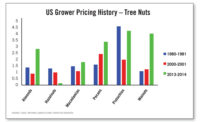Formulation Challenges in Food Products
The lines between foods and dietary supplements continue to blur and more extensive use of bioactive ingredients is clouding the picture. Foods are becoming increasingly nutritionally functional and delivering the health benefits once reserved for supplements. Additionally, many supplements/bioactives are being delivered in food form--chews, beverages, bars, baked goods, etc.
Consumers are looking for solutions to their health and wellness needs and condition-specific bioactives and foods are key future trends, particularly as they become open to receiving supplemental nutrition in the form of food versus supplements or medications.

|
New functional food products launched in the global food and beverage marketplace have included fortification with various bioactives, including vitamins, minerals, antioxidants, omega-3 fatty acids, plant extracts, prebiotics, probiotics and fibers, etc.
Bioactive Utilization - Planning and Information
A great deal of strategic thinking and planning is necessary to develop products with bioactives. Some key questions include: What are the levels of nutrients and functional nutrients in products/ingredient, and are these levels standardized? Do current levels meet efficacy requirements? What claims are permitted? What is the consumer’s perception? What is the cost in-use? Is the ingredient supply secure? Is the clinical research sound and well-documented?
It is important to research bioactives early in the process. A good starting point is to access CARDS. CARDS is the acronym for Computer Access to Research on Dietary Supplements and is a database of federally funded research projects pertaining to dietary supplements. Currently, CARDS contains projects funded by the U.S. Department of Agriculture (USDA), the Department of Defense (DOD) and the Institutes and Centers (ICs) of the National Institutes of Health (NIH) beginning with fiscal year 1999, the first year that NIH ICs began reporting research related to dietary supplements. Projects funded by other federal agencies will be added to CARDS, as they become available. The Office of Dietary Supplements (ODS) will post notices on its website and listserv, when CARDS updates are completed. A search of the CARDS database can be used to sort and tabulate information for a variety of purposes by researchers, marketers and consumers. See http://ods.od.nih.gov/Research/CARDS_Database.aspx .
Regulatory
FDA and USDA claims are extremely limited; recently, even claims supported by relatively robust clinical data has been challenged. In many cases, “name-recognition” regarding ingredient benefits, along with very limited health-related statements, are the only allowable marketing claims (example: green tea).
Another key regulatory issue is whether a food product formulated with a bioactive ingredient is to be marketed as a supplement, and whether this is allowable. Bars, beverages, powders, etc. are common food vehicles in the supplement category; however, FDA has recently cracked down on some of these avenues to market--for example, ready-to-drink beverages.
When considering claims, do not refer to a specific disease state and avoid language which may raise red-flags regarding presenting the bioactive as a drug rather than as a food ingredient.
Before beginning any formulation, determine whether the ingredient is allowed in the food product of interest. Various food categories/products have specific standards of identity and/or restrictions regarding fortification. Also, is the ingredient GRAS or self-affirmed GRAS? Many major manufacturers use only GRAS ingredients.
It is critical that manufacturers, distributors, marketers and retailers of bioactive products comply with applicable regulatory guidelines.
Shelflife Concerns
Many bioactive ingredients are prone to degradation and/or can interact with other components in the food matrix, resulting in loss of quality or nutritional value. Some critical questions which impact shelflife are: How will the ingredient be shipped and stored--packaging or container types, temperature, humidity, time, multi-use containers? What are the processing conditions? What are finished food shelflife considerations and storage conditions?
Depending upon specific finished product claims, the bioactive must be present in the level determined to provide claim efficacy at the end of shelflife. This may lead to overages, or addition of bioactives in excess of claimed levels. The type of food matrix, ingredient interactions, processing, storage/handling, delivery systems, mixing and distribution, the presence/absence of antioxidants, water activity, pH, moisture and chelating agents may all impact bioactive shelflife.
Bioactive ingredients in foods must remain fully functional for as long as necessary and thus must be transported and discharged appropriately to have the desired nutritional effect. Delivery and controlled release systems are an essential way to achieve these aims. This may be accomplished via microencapsulation or utilization of other encapsulation/partitioning/packaging technologies.
Additionally, potency may be compromised by the reaction of a bioactive with other ingredients or premature release and exposure to stomach acids. For example, direct addition of iron may reduce bioavailability through interaction with tannins, phytates and polyphenols; free iron catalyzes lipid oxidation. Omega-3 fatty acids are susceptible to such oxidation and degradation.
Bioactives should be stored under appropriate conditions prior to incorporation into foods and should be isolated from environments that promote degradation or undesirable interactions with light, moisture, heat or oxygen. Shipping and distribution conditions and handling requirements are also important considerations, particularly as related to temperature and humidity.In general, lower temperatures improve bioactive stability.
Flavor
Initial flavor is distinct from flavor changes over time, which may be a metric of bioactive degradation or interaction with other ingredients. Balancing the flavor system and identifying compatible flavors is a bioactive and product-specific process. It is generally useful to look beyond basic flavors and optimize the entire system, including sweeteners and acids. Additionally, targeted masking systems are offered by several manufacturers for specific bioactive compounds, as well as for key negative flavor attributes such as bitter, metallic, sour, etc.
Ideally, the testing of flavor development should be coupled with shelflife testing to understand and anticipate long-term degradation versus intrinsic degradation in-process to optimally develop targeted masking systems.
Standardization of Bioactives
Although the standardization of key bioactive components is generally common from a pharmaceutical standpoint, natural extractives and/or bioactives that occur as a whole food or fraction thereof are often quite variable. Depending on claims, it is critical that specifications are created which demonstrate a level of standardization within delivery tolerances. Additionally, specifications beyond the active component may be required for some delivery forms.
Some critical questions to consider when determining whether a bioactive is suitable for use as a food ingredient: What analytical methods and support are available from the bioactive supplier? What analytical methodology and/or quality control metrics are used by the bioactive manufacturer? Is it necessary for the food processor to implement new analytical methodology?
The ODS launched the Dietary Supplements Analytical Methods and Reference Materials (AMRM) Program in 2002. The program provides information regarding validated analytical methods and reference materials to meet the needs of manufacturers, regulators, contract laboratories, academics and researchers. See http://ods.od.nih.gov/Research/AMRMProgramWebsite.aspx .
Food Safety and Toxicity
Many compounds degrade into toxic forms over time or as a result of processing and interact unfavorably with other ingredient components to generate toxic compounds. Additionally, dosage-control is critical for many bioactive compounds, including commonly used vitamins/minerals, such as vitamin D and selenium. FDA has established fortification limits for some ingredients and these can be found in the Code of Federal Regulations.
It is important to note that where toxicity studies exist, basic model systems or specific matrices may have been used which are not representative of the specific food product or process of interest. Bioactive manufacturers should make information and references to manufacturers available, but again, evaluation in the final product and/or process is critical. NutraSolutions.com
This article is the property of NutraSolutions.com/BNP Media and may not be used or reprinted without permission. ©2011
Looking for a reprint of this article?
From high-res PDFs to custom plaques, order your copy today!








